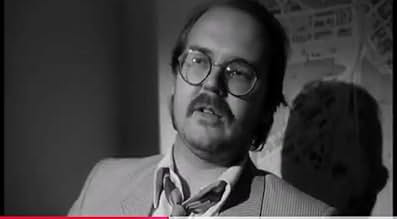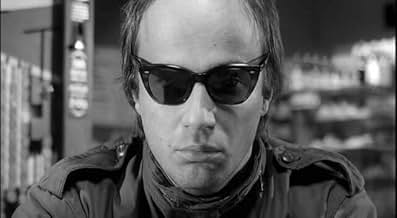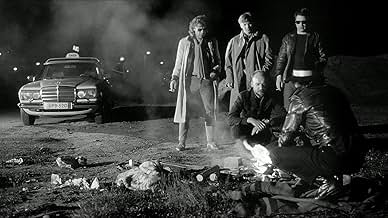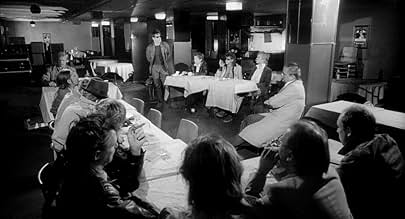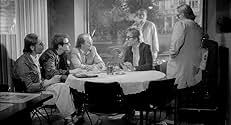IMDb RATING
6.9/10
4.3K
YOUR RATING
An exodus to a better life in Eira. A group of med - all but one - called Frank, seek refuge from their boring lives in an oasis on the other side of the city, having to overcome obstacles o... Read allAn exodus to a better life in Eira. A group of med - all but one - called Frank, seek refuge from their boring lives in an oasis on the other side of the city, having to overcome obstacles on their way.An exodus to a better life in Eira. A group of med - all but one - called Frank, seek refuge from their boring lives in an oasis on the other side of the city, having to overcome obstacles on their way.
Sakari Kuosmanen
- Frank Armoton
- (as Saku Kuosmanen)
Tuomari Nurmio
- Taksikuski
- (as Hannu Nurmio)
- Director
- Writer
- All cast & crew
- Production, box office & more at IMDbPro
Featured reviews
Aki Kaurismäki's career began with the masterpiece Crime & Punishment. However, instead of making something similar immediately afterwards, he chose to follow it with an unconventional, black and white satire, Calamari Union.
The film begins in a bar, a pivotal place in Kaurismaki's movies. It is here we first meet our sixteen protagonists: fifteen men (including Matti Pellonpää, Kari Väänänen and Sakari Kuosmanen) all named Frank (apparently, the director was too lazy to come up with different names for everyone) and a guy named Pekka (Markku Toikka). These people represent the lowlife of Helsinki and, aware of this fact, they decide to go to Eira, the decent part of the city. The journey is described as if it were perilous, and in fact things will take unexpected turns.
Calamari Union is a strange film, as it doesn't follow the rules of conventional plotting. What we see is rather a series of separate, quite amusing incidents involving the Franks and Pekka, the dry, very Finnish humor being an anticipation of Kaurismäki's musical satire Leningrad Cowboys Go America (speaking of music, there's an interesting use of the song Stand By Me - a year ahead of Rob Reiner's eponymous movie).
This may not be the kind of movie people watch on a regular basis, but once it's been seen, it doesn't escape your memory. Perfect for a "different" cinema experience.
The film begins in a bar, a pivotal place in Kaurismaki's movies. It is here we first meet our sixteen protagonists: fifteen men (including Matti Pellonpää, Kari Väänänen and Sakari Kuosmanen) all named Frank (apparently, the director was too lazy to come up with different names for everyone) and a guy named Pekka (Markku Toikka). These people represent the lowlife of Helsinki and, aware of this fact, they decide to go to Eira, the decent part of the city. The journey is described as if it were perilous, and in fact things will take unexpected turns.
Calamari Union is a strange film, as it doesn't follow the rules of conventional plotting. What we see is rather a series of separate, quite amusing incidents involving the Franks and Pekka, the dry, very Finnish humor being an anticipation of Kaurismäki's musical satire Leningrad Cowboys Go America (speaking of music, there's an interesting use of the song Stand By Me - a year ahead of Rob Reiner's eponymous movie).
This may not be the kind of movie people watch on a regular basis, but once it's been seen, it doesn't escape your memory. Perfect for a "different" cinema experience.
After seeing most of Aki Kaurismäki's films and then veering back to his second film, it almost felt like I was watching an all-star cast because most of the actors he collaborated throughout his career is here. And, boy, did I miss my favorite Finnish actor, Matti Pellonpää.
I'm just happy Kaurismäki didn't continue directing while drunk.
It also reminded me of Reservoir Dogs. Did Tarantino saw this movie?
I'm just happy Kaurismäki didn't continue directing while drunk.
It also reminded me of Reservoir Dogs. Did Tarantino saw this movie?
Finnish film "Calamari Union" is not at all a motion picture with a defined setting.It is more of a visual experience with surreal touches which must be seen many times to feel the plight of hapless rock musicians in an urban milieu.In "Calamari Union",there is also a minor battle of sexes to be witnessed as most of the women get their demands met by hapless,vulnerable men.Women are shown as strong willed individuals who would not stop at anything to humiliate, scorn confused men who are treated as mere caddish oafs.Rock music is also one of this film's leading element which reveals the hidden talent of some vagrant musicians.There are some mellifluous tunes which could easily be lapped up by music lovers.No talented film director in the history of modern cinema has come even remotely closer to Finnish author Aki Kaurismaki's vision of urban angst.This is a director who has made an absolutely wise use of his hometown Helsinki and its nocturnal atmosphere by shooting in pristine black and white.He shows why some people are not able to put any order in their utterly disorganized,messy lives.A unique film which is absolutely needed for those nihilists who believe that they are part of existential times.PS:A great film dedicated to Baudelaire,Michaux and Prévert who still hover on earth.Lalit Rao does not care if non Francophones are not aware of Baudelaire,Michaux and Prévert.
A homage to acclaimed 1979 Walter Hill film "The Warriors",(it even features a subway car), done in Kaurismäki peculiar, Godard inspired style, "Calamari Union" shows a group of uniformed named man, as opposed to uniforms of gang colors, fighting their way through Helsinki, trying to get to the promised neighborhood of Eira, not their native, but wishful place of living, where "there are no apartments". Along the way they meet and befall casualties to all sorts of transient enemies, asking for trouble as they go along. Their journey is futile, an attempt to overcome nonexistent and unseen boundaries, doomed from the start. Their resolve is even questionable and strong willed women are often derailing them from their unsure path, as the obstacles appear before them as a mirage.
Shot in typical Kaurismäki minimalist style, black & white photography, improvised dialog on a loosely based script, "Calamari Union", succeeds in bringing a viewer close to chaotic nature of the group's quest. This film is definitely worth repeated viewings, just for substance and style. Recommended.
Shot in typical Kaurismäki minimalist style, black & white photography, improvised dialog on a loosely based script, "Calamari Union", succeeds in bringing a viewer close to chaotic nature of the group's quest. This film is definitely worth repeated viewings, just for substance and style. Recommended.
This film, from the beginning of Kaurismäki's career, reminded me, to a certain extent, of another iconic film about the lost illusions of the 60s and 70s generations, The Wretches Are Still Singing, by the Greek Nikos Nikolaidis.
Of course, Nikolaidis's cinematic language is much more caustic and corrosive. Kaurismäki is faithful to his minimalist principles, as a poet of the absurd. But the essential theme is the same: a lost generation, overtaken by events, that searches, in vain, for a meaning in life in the technocracy that emerged from the rubble of the revolution (real or imaginary).
If Nikolaidis is destructive (and he would be even more so in 1983's Sweet Bunch, in which he practically defends urban guerrilla warfare) Kaurismäki is poetic, transforming disillusionment into a chimerical search for the mythical Eira, Holy Grail of aimless knights, survivors of punk nihilism.
An interesting and original work, even for those who already know Kaurismäki's minimal cinematographic language.
Of course, Nikolaidis's cinematic language is much more caustic and corrosive. Kaurismäki is faithful to his minimalist principles, as a poet of the absurd. But the essential theme is the same: a lost generation, overtaken by events, that searches, in vain, for a meaning in life in the technocracy that emerged from the rubble of the revolution (real or imaginary).
If Nikolaidis is destructive (and he would be even more so in 1983's Sweet Bunch, in which he practically defends urban guerrilla warfare) Kaurismäki is poetic, transforming disillusionment into a chimerical search for the mythical Eira, Holy Grail of aimless knights, survivors of punk nihilism.
An interesting and original work, even for those who already know Kaurismäki's minimal cinematographic language.
Did you know
- TriviaThe first movie ever to include scenes in the Helsinki underground, opened in 1982.
- GoofsThe Director is seen in reflection of Frank's (Sakke Järvenpää) sunglasses in "My friend got sick, can you help us" scene.
- Crazy creditsThe film has virtually no credits at all. There are no opening credits, and in the end, only the text "Loppu" and the production company's name are seen.
- Alternate versionsAll the scenes are intact, but the title card and opening credits are missing from the 2013 (1.85:1) HD master, which is featured in the Finnish streaming service Yle Areena and subsequent Finnish/international television, DVD and Blu-ray releases. The credits originally appear during the early scenes where the "Frank's" initially leave, walk out and past the Kallio Church (followed by a wider shot of the city of Helsinki) and enter the underground metro station. All credits are intact in the older, pre-2013 television airings and home video releases.
- ConnectionsFeatured in Keskiyön auringon kuvat (1987)
- SoundtracksAlkutekstimusiikki
Composed by Aki Kaurismäki
Arranged by Mikko Mattila and Jone Takamäki
Performed by Casablanca Vox and Jone Takamäki
Saxophone: Jone Takamäki
Drums: Kaleva Raittinen
- How long is Calamari Union?Powered by Alexa
Details
- Runtime
- 1h 21m(81 min)
- Color
- Sound mix
- Aspect ratio
- 1.66 : 1
Contribute to this page
Suggest an edit or add missing content



